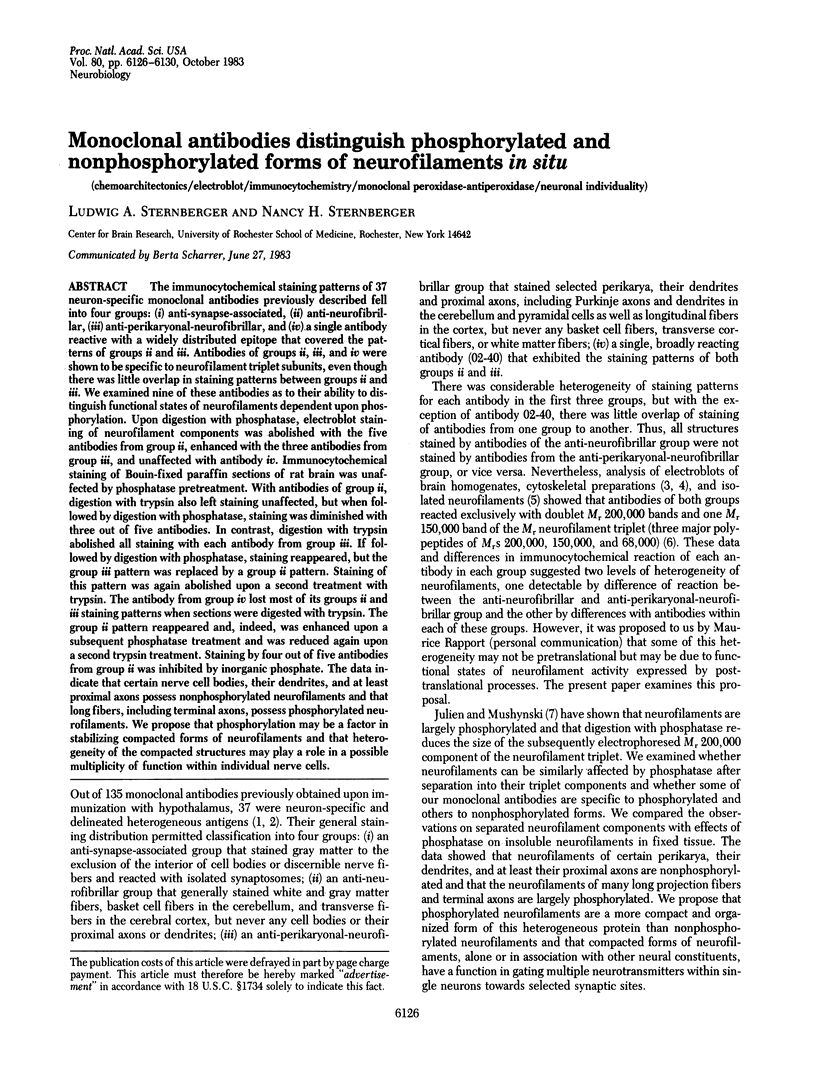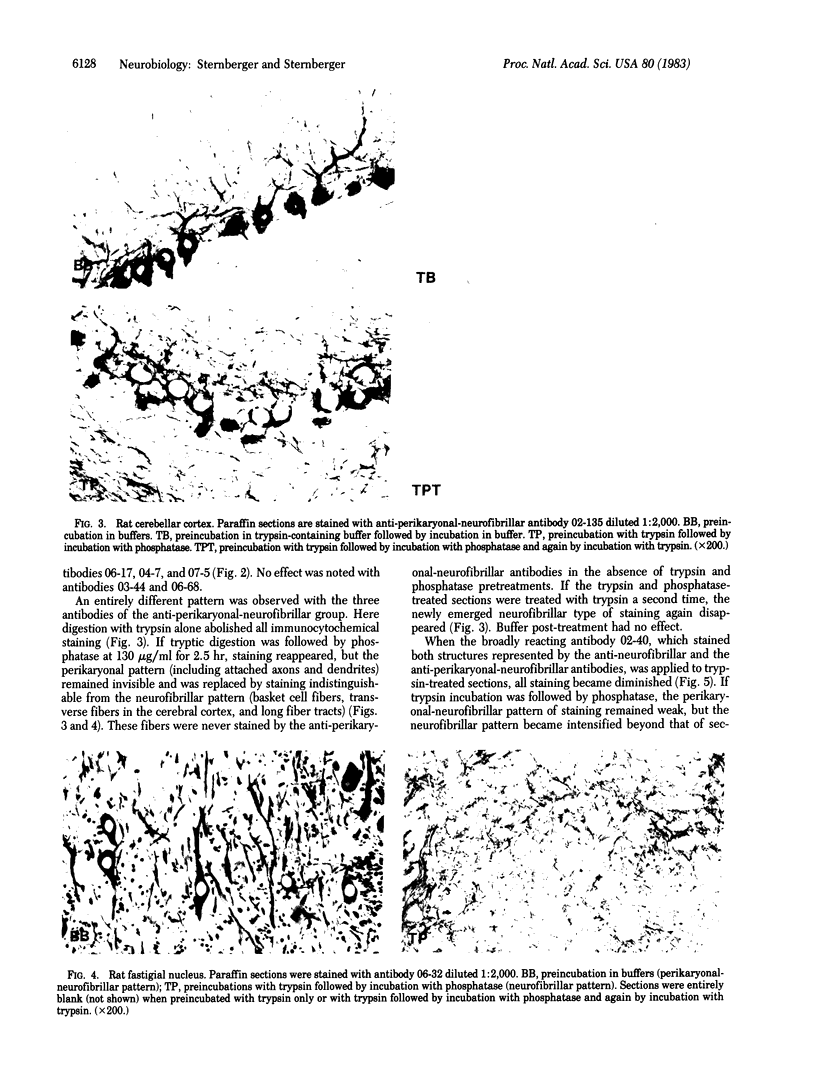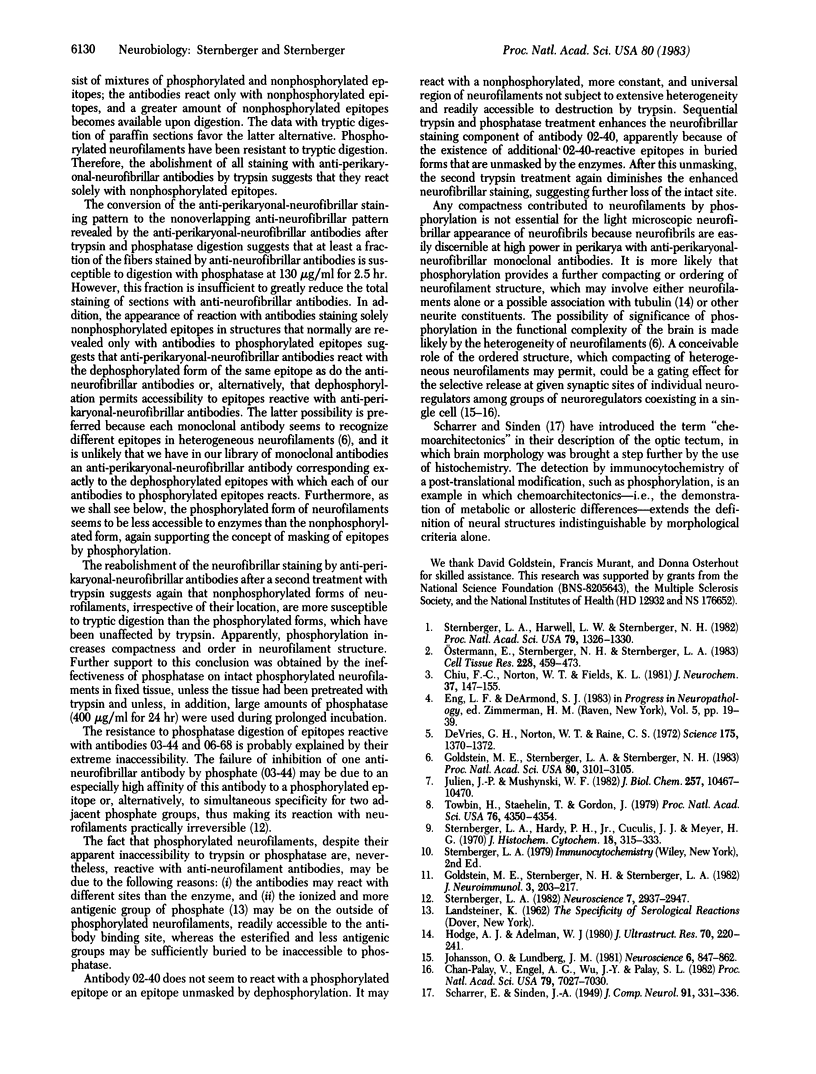Abstract
The immunocytochemical staining patterns of 37 neuron-specific monoclonal antibodies previously described fell into four groups: (i) anti-synapse-associated, (ii) anti-neurofibrillar, (iii) anti-perikaryonal-neurofibrillar, and (iv) a single antibody reactive with a widely distributed epitope that covered the patterns of groups ii and iii. Antibodies of groups ii, iii, and iv were shown to be specific to neurofilament triplet subunits, even though there was little overlap in staining patterns between groups ii and iii. We examined nine of these antibodies as to their ability to distinguish functional states of neurofilaments dependent upon phosphorylation. Upon digestion with phosphatase, electroblot staining of neurofilament components was abolished with the five antibodies from group ii, enhanced with the three antibodies from group iii, and unaffected with antibody iv. Immunocytochemical staining of Bouin-fixed paraffin sections of rat brain was unaffected by phosphatase pretreatment. With antibodies of group ii, digestion with trypsin also left staining unaffected, but when followed by digestion with phosphatase, staining was diminished with three out of five antibodies. In contrast, digestion with trypsin abolished all staining with each antibody from group iii. If followed by digestion with phosphatase, staining reappeared, but the group iii pattern was replaced by a group ii pattern. Staining of this pattern was again abolished upon a second treatment with trypsin. The antibody from group iv lost most of its groups ii and iii staining patterns when sections were digested with trypsin. The group ii pattern reappeared and, indeed, was enhanced upon a subsequent phosphatase treatment and was reduced again upon a second trypsin treatment. Staining by four out of five antibodies from group ii was inhibited by inorganic phosphate. The data indicate that certain nerve cell bodies, their dendrites, and at least proximal axons possess nonphosphorylated neurofilaments and that long fibers, including terminal axons, possess phosphorylated neurofilaments. We propose that phosphorylation may be a factor in stabilizing compacted forms of neurofilaments and that heterogeneity of the compacted structures may play a role in a possible multiplicity of function within individual nerve cells.
Full text
PDF




Images in this article
Selected References
These references are in PubMed. This may not be the complete list of references from this article.
- Chan-Palay V., Engel A. G., Wu J. Y., Palay S. L. Coexistence in human and primate neuromuscular junctions of enzymes synthesizing acetylcholine, catecholamine, taurine, and gamma-aminobutyric acid. Proc Natl Acad Sci U S A. 1982 Nov;79(22):7027–7030. doi: 10.1073/pnas.79.22.7027. [DOI] [PMC free article] [PubMed] [Google Scholar]
- Chiu F. C., Norton W. T., Fields K. L. The cytoskeleton of primary astrocytes in culture contains actin, glial fibrillary acidic protein, and the fibroblast-type filament protein, vimentin. J Neurochem. 1981 Jul;37(1):147–155. doi: 10.1111/j.1471-4159.1981.tb05302.x. [DOI] [PubMed] [Google Scholar]
- DeVries G. H., Norton W. T., Raine C. S. Axons: isolation from mammalian central nervous system. Science. 1972 Mar 24;175(4028):1370–1372. doi: 10.1126/science.175.4028.1370. [DOI] [PubMed] [Google Scholar]
- Goldstein M. E., Sternberger L. A., Sternberger N. H. Microheterogeneity ("neurotypy") of neurofilament proteins. Proc Natl Acad Sci U S A. 1983 May;80(10):3101–3105. doi: 10.1073/pnas.80.10.3101. [DOI] [PMC free article] [PubMed] [Google Scholar]
- Goldstein M. E., Sternberger N. H., Sternberger L. A. Developmental expression of neurotypy revealed by immunocytochemistry with monoclonal antibodies. J Neuroimmunol. 1982 Nov;3(3):203–217. doi: 10.1016/0165-5728(82)90023-6. [DOI] [PubMed] [Google Scholar]
- Hodge A. J., Adelman W. J., Jr The neuroplasmic network in Loligo and Hermissenda neurons. J Ultrastruct Res. 1980 Feb;70(2):220–241. doi: 10.1016/s0022-5320(80)80007-4. [DOI] [PubMed] [Google Scholar]
- Johansson O., Lundberg J. M. Ultrastructural localization of VIP-like immunoreactivity in large dense-core vesicles of 'cholinergic-type' nerve terminals in cat exocrine glands. Neuroscience. 1981;6(5):847–862. doi: 10.1016/0306-4522(81)90167-6. [DOI] [PubMed] [Google Scholar]
- Julien J. P., Mushynski W. E. Multiple phosphorylation sites in mammalian neurofilament polypeptides. J Biol Chem. 1982 Sep 10;257(17):10467–10470. [PubMed] [Google Scholar]
- Ostermann E., Sternberger N. H., Sternberger L. A. Immunocytochemistry of brain-reactive monoclonal antibodies in peripheral tissues. Cell Tissue Res. 1983;228(3):459–473. doi: 10.1007/BF00211468. [DOI] [PubMed] [Google Scholar]
- SCHARRER E., SINDEN J. A contribution to the chemoarchitectonics of the optic tectum of the brain of the pigeon. J Comp Neurol. 1949 Dec;91(3):331-6, illust. doi: 10.1002/cne.900910302. [DOI] [PubMed] [Google Scholar]
- Sternberger L. A., Hardy P. H., Jr, Cuculis J. J., Meyer H. G. The unlabeled antibody enzyme method of immunohistochemistry: preparation and properties of soluble antigen-antibody complex (horseradish peroxidase-antihorseradish peroxidase) and its use in identification of spirochetes. J Histochem Cytochem. 1970 May;18(5):315–333. doi: 10.1177/18.5.315. [DOI] [PubMed] [Google Scholar]
- Sternberger L. A., Harwell L. W., Sternberger N. H. Neurotypy: regional individuality in rat brain detected by immunocytochemistry with monoclonal antibodies. Proc Natl Acad Sci U S A. 1982 Feb;79(4):1326–1330. doi: 10.1073/pnas.79.4.1326. [DOI] [PMC free article] [PubMed] [Google Scholar]
- Sternberger L. A. Transition of immunocytochemistry from an anatomical to a biochemical science: evolution of the concept of neurotypy. Neuroscience. 1982;7(12):2937–2947. doi: 10.1016/0306-4522(82)90223-8. [DOI] [PubMed] [Google Scholar]
- Towbin H., Staehelin T., Gordon J. Electrophoretic transfer of proteins from polyacrylamide gels to nitrocellulose sheets: procedure and some applications. Proc Natl Acad Sci U S A. 1979 Sep;76(9):4350–4354. doi: 10.1073/pnas.76.9.4350. [DOI] [PMC free article] [PubMed] [Google Scholar]

















